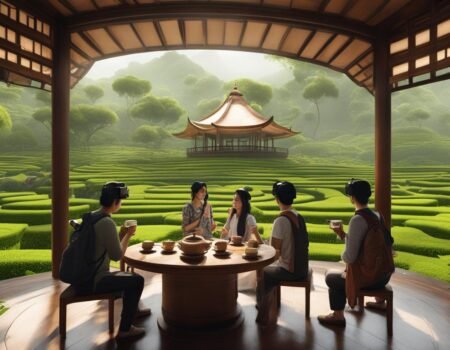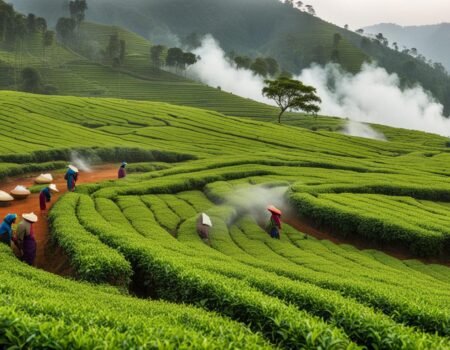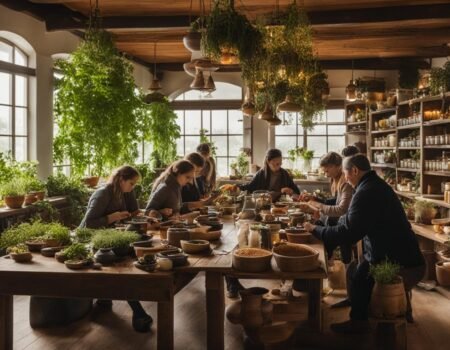
The Aesthetics of Modern Tea Culture: Style and Substance
Welcome to our exploration of the mesmerizing world of modern tea culture! In this article, we will delve into the captivating aesthetics that surround tea, transforming it from a mere beverage into a symbol of style, artistic expression, and lifestyle trends. Join us as we unravel the visual art, branding, tea serving rituals, and the elegance of modern tea spaces. Get ready to be inspired by the beauty and grace that accompanies every sip of tea!
Key Takeaways:
- Modern tea culture embraces aesthetics, allowing individuals to showcase their personal style and lifestyle trends.
- Visual art in tea culture captures the beauty and essence of this ancient tradition, with contemporary tea art galleries showcasing artistic expressions.
- Tea culture branding and design create an aesthetic experience, from the packaging to the visual merchandising of tea shops.
- The art of tea serving elevates the experience, adding elegance and creativity to the modern tea culture.
- Tea culture influences various aspects of contemporary living, including fashion, home decor, and even modern art.
Exploring Visual Art in Modern Tea Culture
Visual art plays a significant role in the aesthetics of modern tea culture. Artists and photographers have skillfully captured the beauty and essence of tea culture through their artwork and photography, showcasing the visual appeal of this ancient tradition.
Contemporary tea art galleries provide a platform for artists to display their works inspired by tea, creating a space where art enthusiasts and tea lovers can come together to appreciate the marriage of artistic expression and tea culture. These exhibitions not only celebrate the artistry of tea but also offer insights into the cultural significance and symbolism associated with this revered beverage.
Through their creative interpretations, artists and photographers bring new perspectives to the world of tea, shedding light on the depth and complexity of this age-old tradition. Their art captures the intricate details of tea rituals, the serenity of tea ceremonies, and the craftsmanship behind tea sets and utensils. By visualizing the art of tea, these artists offer a unique lens through which we can deepen our understanding and appreciation of tea culture.
Table: Contemporary Tea Art Galleries
| Gallery Name | Location | Featured Artists |
|---|---|---|
| TeaArt Gallery | New York City, NY | Grace Lin, Wang Mei, Chen Li |
| ArtTea House | San Francisco, CA | Hiroshi Nakamura, Mei Ling, Li Wei |
| TeaScape Gallery | London, UK | Alice Wong, James Turner, Zhang Wei |
“Art allows us to see the beauty in the mundane, and tea culture provides the perfect canvas for artistic expression. Through visual art, we can immerse ourselves in the enchanting world of tea and discover new dimensions of its timeless appeal.”
Tea Culture Branding and Design
In the modern era, tea culture goes beyond the simple act of brewing and sipping tea. It has become an experience that engages all senses, encompassing aesthetics, branding, and design. Tea culture branding and design play a crucial role in creating an aesthetic journey for tea enthusiasts, immersing them in a visually captivating world of tea. From the moment the tea packaging catches the eye to the ambiance of a tea shop, every detail is carefully curated to enhance the overall tea-drinking experience.
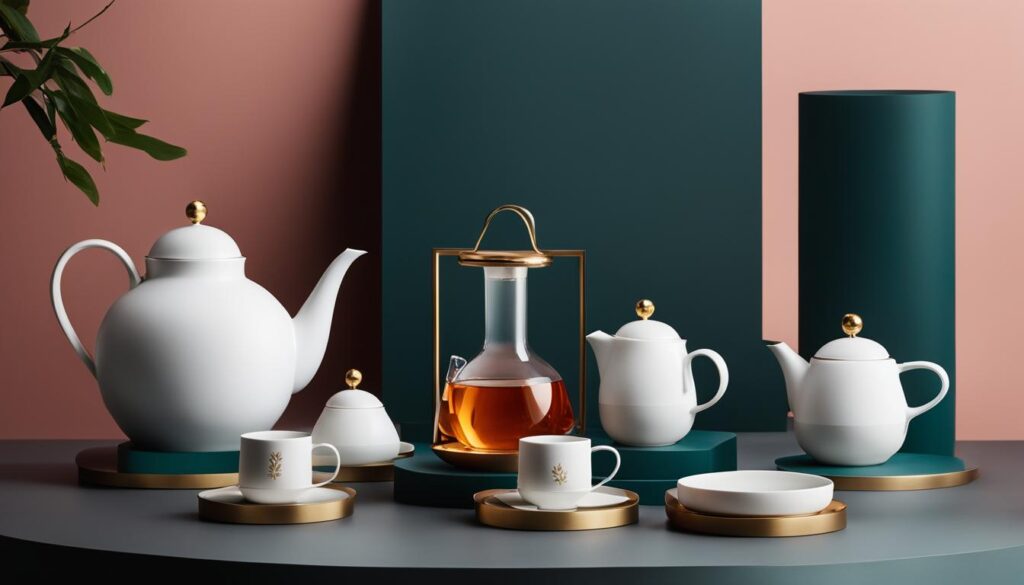
One aspect of tea culture branding and design is the emphasis on aesthetic tea packaging designs. Tea companies strive to create packaging that not only protects the tea but also reflects the values and style of the brand. Elegant and visually appealing packaging designs not only entice customers but also communicate the quality and uniqueness of the tea inside. Whether it’s a minimalist design or a vibrant and intricate artwork, the packaging becomes a window into the world of tea and sets the tone for the tea-drinking experience.
Another important aspect is tea culture visual merchandising. Tea shops are designed to create a serene and inviting atmosphere, where customers can immerse themselves in the beauty of tea. The arrangement of tea sets, accessories, and other tea-related products is carefully curated to showcase the aesthetic appeal of the tea culture. Visual merchandising techniques, such as strategic lighting, displays, and signage, are employed to create an ambiance that exudes elegance and sophistication.
To fully appreciate the impact of tea culture branding and design, it’s essential to visit a tea shop that embodies these principles. Step into a tea shop created with a focus on aesthetics, and you’ll find yourself surrounded by the beauty and elegance of tea. The carefully selected furniture, the delicate porcelain tea sets, and the serene colors all come together to create an environment that evokes a sense of calm and tranquility. It’s a place where tea enthusiasts can indulge in the visual pleasures of tea culture while savoring their favorite brew.
The Art of Tea Serving
In the world of modern tea culture, serving tea is not just a simple act but an art form that embodies elegance and style. Tea enthusiasts and tea houses have embraced creative and aesthetic tea serving ideas, elevating the tea-drinking experience to new heights. From intricate tea sets to innovative tea ceremony rituals, tea serving has become a visual spectacle that captivates both the eyes and the taste buds.
Aesthetic Tea Serving Ideas
When it comes to serving tea, aesthetics play a crucial role in creating a memorable experience. Tea enthusiasts have embraced aesthetic tea serving ideas that go beyond the traditional teapot and cup. For example, tea can be served in delicate glass teaware that showcases the vibrant colors of the tea leaves brewing. The transparency of the glass allows tea drinkers to appreciate the visual beauty of the tea as it infuses with the water.
Another popular aesthetic tea serving idea is the use of unique tea vessels and accessories. From porcelain gaiwans to clay teapots, these vessels add a touch of sophistication to the tea ceremony. Delicate tea cups with intricate designs and patterns further enhance the overall aesthetic appeal of the tea serving experience.
Contemporary Tea Culture Rituals
| Tea Ritual | Description |
|---|---|
| Gongfu Cha | A Chinese tea ceremony characterized by its meticulous preparation and presentation. It involves multiple steeping of tea leaves in small teapots, using precise measurements and timing. |
| Japanese Tea Ceremony | An ancient ceremonial tradition that focuses on the preparation, serving, and drinking of Matcha, a powdered green tea. It emphasizes mindfulness, respect, and harmony. |
| Moroccan Tea Ceremony | A vibrant and communal tea ritual that involves the preparation and serving of sweet mint tea in ornate teapots. It symbolizes hospitality and friendship. |
These contemporary tea culture rituals not only showcase the artistry of tea serving but also provide a deeper connection to the heritage and traditions of different tea-drinking cultures around the world.
Tea Culture and Lifestyle Trends
Tea culture has transcended its traditional roots and become a prominent influence in modern lifestyle trends. From fashion to home decor, the aesthetics of tea culture have found their way into various aspects of contemporary living. The soothing and elegant qualities of tea have struck a chord with individuals seeking a sense of tranquility and mindfulness in their daily lives.
One area where tea culture has made a significant impact is in modern art. Artists have embraced tea as a symbol of harmony and balance, incorporating it into their artwork in various forms. Whether it’s a painting, sculpture, or installation, tea-related themes and symbols can be found in galleries and exhibitions, inviting viewers to contemplate the connection between tea and the human experience.
In addition to the influence on art, tea culture has also influenced the way people socialize and connect with others. Tea houses and tea shops have become popular gathering places for friends, colleagues, and even strangers to come together over a shared love for tea. These spaces are designed with aesthetics in mind, creating a serene and inviting atmosphere where people can relax, converse, and enjoy the sensory experience of tea.
The Intersection of Tea Culture and Lifestyle Trends
Tea culture has seamlessly merged with lifestyle trends, reflecting the desire for simplicity, mindfulness, and self-care. This trend is evident in the popularity of tea ceremonies and rituals, where individuals take the time to prepare and savor a cup of tea with intention and focus. The act of brewing and enjoying tea has become a ritualistic practice that allows people to slow down and appreciate the present moment.
Furthermore, tea culture has influenced the aesthetic choices people make in their daily lives. From minimalist tea sets and teaware to earthy and natural home decor, tea culture aesthetics have become synonymous with simplicity, authenticity, and a connection to nature. This lifestyle trend extends beyond the act of drinking tea and permeates through various aspects of daily life.
As tea culture continues to evolve and adapt to modern times, its impact on lifestyle trends and artistic expression will undoubtedly continue. The ability of tea to soothe the soul, promote mindfulness, and foster connections with others makes it a timeless symbol of elegance and serenity in an ever-changing world.
| Tea Culture and Lifestyle Trends | Tea Culture in Modern Art |
|---|---|
| Tea culture has influenced various aspects of contemporary living. | Artists incorporate tea-related themes and symbols into their artwork. |
| Tea culture aesthetics have found their way into fashion, home decor, and more. | Tea-inspired paintings, sculptures, and installations can be found in galleries. |
| Tea houses and tea shops serve as gathering places for tea enthusiasts. | Tea-related art invites contemplation on the connection between tea and humanity. |
| Tea ceremonies and rituals reflect the desire for simplicity and mindfulness. | Tea culture serves as a symbol of harmony and balance in artistic expression. |
| Tea culture aesthetics promote authenticity and a connection to nature. | Tea-related art exemplifies elegance, serenity, and timeless beauty. |
The Elegance of Modern Tea Spaces
When it comes to modern tea culture, the aesthetics extend beyond the taste and presentation of the beverage itself. Tea spaces, such as tea shops and tea houses, have become a haven for tea enthusiasts seeking not only a delicious cup of tea but also an immersive and visually appealing experience. From the moment you step into these spaces, you are transported into a world of elegance and tranquility.
One of the key elements that contribute to the overall aesthetic of tea spaces is the concept of visual merchandising. Tea culture visual merchandising techniques are employed to create a harmonious and inviting ambiance. The careful arrangement of tea sets, accessories, and decor elements in these spaces is designed to inspire and captivate visitors. The combination of soothing colors, natural materials, and exquisite details creates an environment that is both aesthetically pleasing and conducive to relaxation and enjoyment.
Aesthetic tea shops and contemporary tea houses are not just places to enjoy a cup of tea; they are also curated spaces that showcase the beauty and artistry of tea culture. The interior design of these spaces often takes inspiration from traditional tea houses while incorporating modern elements to create a unique and captivating atmosphere. From the choice of furniture to the lighting and music, every aspect is carefully considered to enhance the overall tea-drinking experience.
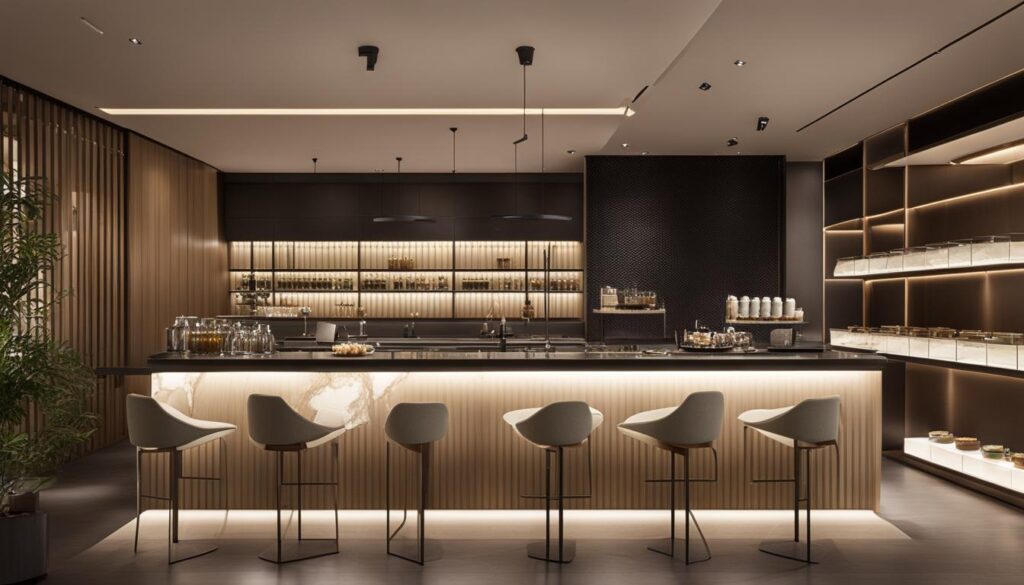
Moreover, these modern tea spaces serve as a hub for social interaction and community engagement. They host tea tastings, workshops, and other events that bring people together to learn, connect, and appreciate the rich heritage and aesthetics of tea culture. Whether you are a tea connoisseur, an artist seeking inspiration, or someone looking for a serene retreat from the bustling city life, these tea spaces offer a haven of elegance and tranquility for all.
Modern Tea Culture Photography and Art Exhibitions
The visual beauty and cultural significance of modern tea culture are brought to life through the lens of photography and showcased in art exhibitions. Professional photographers and artists capture the essence of tea culture, highlighting its elegance, tradition, and artistic expressions. These stunning visuals provide a unique and immersive experience for both tea enthusiasts and art lovers.
Exploring Modern Tea Culture through Photography
Modern tea culture photography captures the intricate details and moments of tea preparation, serving, and consumption. From close-up shots of tea leaves and graceful pouring of tea to serene tea ceremonies and captivating tea sets, these photographs offer a glimpse into the aesthetic world of tea culture. Through the lens, we witness the meticulousness and artistry that go into the process of tea-making.
“Tea is not just a beverage, but a work of art in itself. Through photography, we can showcase the beauty and cultural importance of tea, and invite people to explore the world of tea culture,” says renowned photographer Jane Thompson.
Art exhibitions centered around modern tea culture provide a platform for artists to showcase their works inspired by tea. These exhibitions feature a variety of art forms, including paintings, sculptures, installations, and multimedia pieces, all centered around the theme of tea. It is a celebration of the fusion between tea and art, where creativity and imagination intertwine to create thought-provoking and visually engaging compositions.
Contemporary Tea Art Galleries
In contemporary tea art galleries, visitors can immerse themselves in a world where tea culture meets modern art. These galleries curate exhibitions that explore the different facets of tea culture, presenting artworks that depict the beauty, symbolism, and cultural significance of tea. Art enthusiasts and tea lovers alike can appreciate the unique perspectives and interpretations of artists who have found inspiration in this ancient tradition.
Through modern tea culture photography and art exhibitions, we gain a deeper understanding and appreciation for the aesthetics of tea. These visual representations not only capture the essence of tea culture but also serve as a source of inspiration for both artists and tea enthusiasts, bridging the gap between tradition and contemporary expression.
| Table: Tea Culture Photography and Art Exhibitions |
|---|
| Tea culture photography captures the beauty and artistry of tea preparation and consumption. |
| Art exhibitions showcase a variety of art forms inspired by tea culture. |
| Contemporary tea art galleries provide a platform for artists to display their tea-inspired works. |
| The fusion of tea and art offers a unique and immersive experience for visitors. |
Conclusion
As we wrap up our exploration of modern tea culture, we can’t help but marvel at the aesthetics that surround this timeless beverage. It’s not just about the taste, but also the visual art, branding, design, and the overall experience. The beauty of modern tea culture lies in its ability to seamlessly blend tradition with contemporary lifestyle trends.
Tea has emerged as more than just a drink; it has become a symbol of personal style and a reflection of one’s values. From the artistic expressions captured in photography and art exhibitions to the carefully curated branding and design of tea packaging and shops, every element has been thoughtfully crafted.
But the influence of tea culture doesn’t stop there. It has permeated into various aspects of modern life, from fashion and home decor to the world of contemporary art. Artists have found inspiration in tea culture, incorporating its themes and symbols into their works.
By embracing the aesthetics of modern tea culture, we can enter a world of elegance and serenity. We can appreciate the beauty of this ancient tradition in a contemporary context and tap into the ever-changing lifestyle trends that it influences. So, let’s raise our teacups and toast to the modern tea culture aesthetics that continue to captivate us.
FAQ
What is modern tea culture?
Modern tea culture is not just about the beverage itself, but also about the aesthetics and style that surround it. It incorporates elements of artistic expression, visual art, branding and design, tea serving, and lifestyle trends.
How does visual art play a role in modern tea culture?
Visual art is a significant part of modern tea culture aesthetics. Artists and photographers capture the beauty and essence of tea culture through their artwork and photography, which can be showcased in contemporary tea art galleries.
What is the role of branding and design in tea culture?
Tea culture branding and design create an aesthetic experience for tea enthusiasts. From the design of tea packaging to the visual merchandising of tea shops, every detail reflects the style and values of the tea culture.
How does tea serving contribute to the aesthetics of modern tea culture?
Tea serving is an art in itself and adds elegance and style to modern tea culture. Creative and aesthetic tea serving ideas, such as decorative tea sets and innovative tea ceremony rituals, elevate the overall experience.
How has tea culture influenced lifestyle trends?
Tea culture has made its way into fashion, home decor, and modern art. Its aesthetics have become a part of contemporary living, with artists incorporating tea-related themes and symbols into their artwork.
What makes modern tea spaces elegant?
Modern tea spaces, including tea shops and tea houses, are designed with aesthetics in mind. From the interior design to the arrangement of tea sets and accessories, these spaces create an elegant and serene ambiance.
Are there photography and art exhibitions focusing on modern tea culture?
Yes, photography and art exhibitions showcasing the beauty and cultural significance of tea have gained popularity. Contemporary tea art galleries provide a platform for artists to display their works inspired by tea culture.
What does modern tea culture aesthetics encompass?
Modern tea culture aesthetics go beyond the beverage itself and include visual art, branding and design, tea serving, and the overall tea-drinking experience. It has had a significant influence on lifestyle trends and contemporary art.



